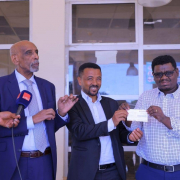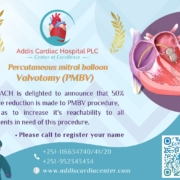VALVOTOMY CAMPAIGN
Addis Cardiac Hospital is delighted to announce that 50% price reduction is made to percutaneous mitral balloon valvotomy procedure, so as to increase it’s reachability to all patients in need of this procedure.
ACH had carefully crafted a relocation project
In a bid to expand its services and to widen its human development endeavor, ACH had carefully crafted a relocation project and had approached
Ethiopia Buna football club player’s check-ups at ACH.
ACH has a comprehensive general and cardiac check up programs providing to the general population and specific groups like professional/amateur athletes and football players.
All check ups and screenings are completed in one day.
ACH had a privilege of screening football players of Ethiopia Buna the most famous football club in Ethiopia. Applying the scientific guidelines for athletes and football players, which is a rigorous screening test, all Ethiopia Buna players were certified to participate on African Confederation Cup.
Medical Screening for football players
There are some details of the medical screening that is performed for international football players. This medical screening is very comprehensive, and is divided into the following components:
A. HISTORY
Personal Football History – details of playing position, dominant leg and number of games played in previous year.Medical History
Family history is medical condition. Player medical history. Current complaints and symptoms.Current medication and vaccination
B. MEDICAL EXAMNATIONS
General Medical Exam – a routine physical examination conducted by the doctor, such as blood pressure, heart and chest sounds, reflexes.
Special Cardiological Examination – Resting 12-lead electrocardiogram (ECG), Stress (exercise) ECG and Trans-Thoracic Echocardiography (TTE), (if indicated conducted during exercise.)
Laboratory Examination – a blood count and urine test is mandatory, with a range of other tests recommended.
Orthopedic Examination and Functional Tests – there are mandatory inspection and functional examination tests of the spinal column, shoulder, hip, knee, lower leg, ankle and foot. Other tests that are recommended are range of motion tests, muscle balance and muscle strength (one-leg hop).
Radiological Examination and Ultrasound Scan – if required based on the above examinations.
Angiography
A 39 years old male who has diabetes for 30 years presented to out center with sudden onset left side severe chest pain associated with fatigue and difficulty of breathing.
He was evaluated at our Emergency OPD and found to have heart attack (Acute Myocardial infarction/AMI. He was stabilized and all the necessary drugs were given.
He was then immediately taken to the Cath lab where it was found that one of his main blood vessel that supply heart muscle with blood (coronary artery) was totally blocked.
His blocked vessel was opened with the procedure called PCI. see the video below, as the arrow indicates the closed vessel can be seen open after the interventions.
He was okay after the procedure and he was discharged home after 48hrs of hospital stay.
We advise any person experiencing chest pain especially new onset chest pain or difficulty of breathing that worsens with walking and related symptoms to have immediate cardiac checkup.
NB
Cath lab is an examination room in a hospital or clinic with diagnostic imaging equipment used to visualize the arteries of the heart and the chambers of the heart and treat any stenosis or abnormality found.
PCI-Percutaneous coronary intervention is a non-surgical method used to open narrowed arteries that supply heart muscle with blood (coronary arteries)
Cath Lab
What are cardiac pacemakers?
Pacemakers are devices used for the treatment of some types of heart beat (cardiac rhythm) abnormalities.
Historic Back Ground
The 1st case of human cardiac pacing was performed by and Australian anesthesiologist, Marck C Lidwalell in 1929. In Ethiopia it has not been a decade since permanent cardiac pacemaker implantation was started and currently Addis cardiac hospital gives such treatment (pacemaker, ICD and CRT) by experienced cardiologist.
Components of pacemaker device.
- Generator; source of energy for the pacemaker
- Pacemaker Leads: special wires which connect the generator with the heart
Types of pacemakers.
- Single chamber: lead implanted into only one cardiac chamber
- Double chamber; leads implanted into two cardiac chambers
Uses of pacemaker.
Pacemakers are used for the treatment of heart beat (heart rhythm) abnormalities such as very slow heart rate causing weakness, shortness of breath loss of consciousness etc.
How are pacemakers implanted?
Pacemakers are implanted in an a wake patient by using local anesthetic and making small incision in the upper anterior chest followed by advancing leads (Special wires) through veins with the help of X-Ray Machine and placing the battery (generator) under the tissue below the skin.
What are the risks of pacemaker implantation?
In skilled hands, the majority of pacemakers (95%) are implanted without any complication
Possible complications in the remaining patients include:-
- The lead or the wire may detach from the heart (1 in 25 people).
- Bleeding into generator insertion site (1 in 30 people)
- Infection of pacemaker insertion site (1 in 100 people).
- Injury to the lung which may require tube insertion in to the chest.
Rarely (1 in 1,000 people), puncture of the heart (Tamponade) may occur and may need removal or at times it could even be fatal
Care and precautions to be taken by the patient who has pacemaker
- The patient is advised to consult the physician if he has pain, swelling or bleeding at the pacemaker insertion site.
- For two weeks after implantation, avoid driving and overuse of the arm on the side of the generator
- Regular follow-up on appointment days or if there are new symptoms
- Depending on how much the patient is pacemaker dependent, generator change may be required after 5-10 years of implantation
- Since some investigations like MRI and some surgical instruments may interfere with the function of pacemaker, the patient should consult the doctor or cardiologist before undergoing such investigations or procedures
- Carry pacemaker identification card
- Pass through security instruments or metal detectors at a faster pace and avoid standing near such instruments for long time
- Avoid keeping activated phones on the same side of pacemaker generator and use the opposite ear when using the phone.
Implantable cardioverte defibrillator (ICD)
An ICD is an implantable device similar to pacemakers used for the detection and treatment of serious and rapid heart beat abnormalities which could be life threatening if not reverted to normal
An ICD revert such dangerous heart beat (heart rhythm) abnormalities by discharging electric shock.
It is commonly implanted for patients who are at high risk of sudden cardiac death such as patients who have survived cardiac arrest and some patients with serious underlying hear disease
A patient with and ICD should avoid driving at least for the first 6 months.
Cardiac resynchronization therapy (CRT)
It is a type of pacemaker used for the treatment of selected patients with medically refractory heart failure
New site for ACH
Addis Cardiac Center (ACH) is happy to introduce its brand new website developed by eTech.
The site is aimed to make Addis Cardiac Center more accessible by its clients and provide up-to-date information.
Open Heart surgery
Valve surgery, coronary artery bypass grafting (CABG) and congenital l defect (“ birth defects”) repair are types of cardiac surgical procedures performed.
What are Heart Valves?
Valves are one-way gates in the heart that keep blood flowing between the chambers and in the same direction. There are four valves in the heart, and each one has flap-like “ doors” (called cusps or leaflets) that open and close with each heartbeat. The two most common heart valve conditions are:
- Narrowing (” stenosis”) when a valve doesn’t open fully.
- Leakage (“ insufficiency “ or “ regurgitation”) when the valve doesn’t close tightly.
Heart Valve surgery:- The goal of this operation is to Repair (mend the valve to help it work better) or Replace one or more malfunctioning heart valve with a new valve (Mechanical or Biological).
Types of prosthetic valves– The choice between the two types depends on certain patient characteristics and ability to take lifelong anticoagulant (blood thinner).
- Mechanical valves are created from man – made materials and are designed to last forever but have a higher risk of blood clot formation on them. Lifetime therapy with blood thinner is needed.
- Biological (tissue) valves are made of animal or human tissue. They don’t last as long as mechanical valves, degenerate (Wear out) typically lasting about 10-15 years and another open- heart operation to replace the valve may be needed. However, long-term use of an anticoagulant is often not needed.
What does Coronary artery bypass grafting (CABG) or Bypass Surgery Means?
Narrowing of the arteries that branch off from the body’s main blood supplier called the “ aorta” to feed the heart is called coronary artery disease (CAD) CAD prevents the heart from getting the blood and oxygen it needs giving rise to chest pain or heart attack. The goal of coronary artery bypass grafting (GABG) is to improve blood flow to the heart. Bypass means and alternate route. In CABG operation healthy veins or arteries from another part of the body are taken and used to build a new road and “ bypass: the blockage in a diseased coronary artery.
How is open heart surgery performed?
- Patient is put under general anesthesia (Completely asleep)
- An incision is made in the sternum (breastbone) to open the chest and gain access to the heart
- During valve surgery (& most CABG), the heart must not beat and is temporarily stopped using chemicals or cold (hypothermia).
- When the heart is stopped, blood circulation is maintained with a heart-lung machine or a cardiopulmonary bypass machine. This functions like the heart and lungs, circulating blood and providing oxygen to the body. The body is connected to the machine through the vessels in the heart or groin
- Unlike other kinds of heart surgery, the chambers of the heart are not opened during bypass surgery
- Once the surgery is done, the heart and lungs take over again.
What are the risk of open heart surgery?
As no procedure can ever be truly free of risks, open heart surgery too has its sets of minor and major complications. The risks very from patient to patient as well as from one type of hear surgery to another possible complications include:
- Bleeding at the incision site or from the area of the heart where srgery performed is common transfusion of >10 units may be necessary in 3-5%
- Abnormal heart rhythm (up to 15-60%): in rare cases a temporary external, or permanent internal pacemaker may be necessary to correct this problem
- An emergency surgery may be necessary to repair andy problems.
- Heart attack (1-4)
- Death (2-10.3%) in different types of heart surgeries
- Stroke & deterioration in intellectual function (2-4%)
- Wound breakdown
- Respiratory complication
- Kidney failure (up to 30%)
- Infections may occur
- Cardiac tamponade: A life- threatening condition where the pericardium, the sac surrounding the heart fills with bblood may also occur.








